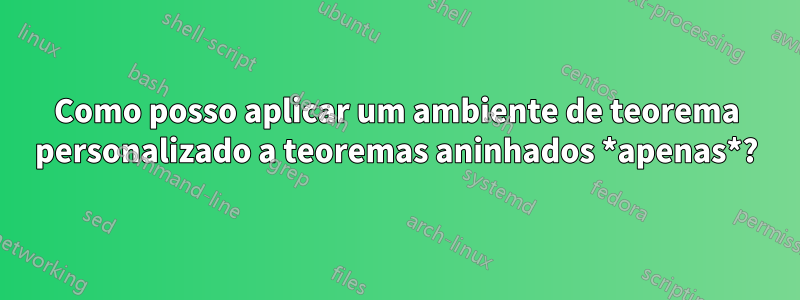
Emum tópico anterior, perguntei sobre a possibilidade de definir um ambiente de teorema personalizado cujo símbolo QED seria uma versão em caixa do nome/número/rótulo do teorema. Lá, recebi gentilmente a seguinte solução:
\documentclass{book}
\usepackage{amsthm,xpatch}
\makeatletter
\let\qed@empty\openbox % <--- change here, if desired
\def\@begintheorem#1#2[#3]{%
\deferred@thm@head{%
\the\thm@headfont\thm@indent
\@ifempty{#1}
{\let\thmname\@gobble}
{\let\thmname\@iden}%
\@ifempty{#2}
{\let\thmnumber\@gobble\global\let\qed@current\qed@empty}
{\let\thmnumber\@iden\xdef\qed@current{#2}}%
\@ifempty{#3}
{\let\thmnote\@gobble}
{\let\thmnote\@iden}%
\thm@swap\swappedhead
\thmhead{#1}{#2}{#3}%
\the\thm@headpunct\thmheadnl\hskip\thm@headsep
}\ignorespaces
}
\renewcommand{\qedsymbol}{%
\ifx\qed@thiscurrent\qed@empty
\qed@empty
\else
\fbox{\scriptsize\qed@thiscurrent}%
\fi
}
\renewcommand{\proofname}{%
Proof%
\ifx\qed@thiscurrent\qed@empty
\else
\ of \qed@thiscurrent
\fi
}
\xpretocmd{\proof}{\let\qed@thiscurrent\qed@current}{}{}
\newenvironment{proof*}[1]
{\def\qed@thiscurrent{\ref{#1}}\proof}
{\endproof}
\makeatother
\newtheorem{thm}{Theorem}[section]
\newtheorem{lem}[thm]{Lemma}
\newtheorem*{nthm}{Theorem}
\begin{document}
\chapter{Title}
\section{Title}
\begin{thm}
Pigs can fly.
\end{thm}
\begin{proof}
Would you doubt it?
\end{proof}
\begin{nthm}
Unnumbered.
\end{nthm}
\begin{proof}
What should we say?
\end{proof}
The following theorem will be proved later.
\begin{thm}\label{thm:later}
$P=NP$.
\end{thm}
Long text here.
\begin{proof*}{thm:later}
Oh, well! Should I really do it? We'll use the following lemma.
\begin{lem}
Something surely can fly.
\end{lem}
\begin{proof}
Clear.
\end{proof}
Now use the lemma and apply the well known identity
\[
1=0.\qedhere
\]
\end{proof*}
\end{document}
O resultado desse código é o seguinte:

É possível modificar o código fornecido de forma a "detectar aninhamento", ou seja, de modo que os teoremas/lemas/proposições no "nível superior" (não aninhados) mantenham seu símbolo QED usual enquanto os teoremas/lemas/proposições nos níveis subsequentes (aqueles que estão aninhados nos de nível superior) são designados como tal com símbolos QED que são os nomes/números/rótulos em caixas dos teoremas/lemas/proposições?
Além do código acima, não tenho um MWE porque literalmente não tenho ideia de como codificar tal coisa. Encontrei alguns outros fóruns sobre TeX.SX (aquieaqui) que tratam da formatação de ambientes aninhados, mas nunca consegui adaptar o código que possuo ao código fornecido nele.
Qualquer ajuda seria muito apreciada.
Responder1
A ideia é adicionar uma condicional que seja verdadeira quando uma prova começa e alterar o código de acordo: se a condicional for falsa, não estamos aninhando, então definimos como \qed@current, \qed@emptycaso contrário usamos o mesmo mecanismo da outra resposta.
\documentclass{book}
\usepackage{amsthm,xpatch}
\makeatletter
\let\qed@empty\openbox % <--- change here, if desired
\def\@begintheorem#1#2[#3]{%
\deferred@thm@head{%
\the\thm@headfont\thm@indent
\@ifempty{#1}
{\let\thmname\@gobble}
{\let\thmname\@iden}%
\@ifempty{#2}
{\let\thmnumber\@gobble\global\let\qed@current\qed@empty}
{\let\thmnumber\@iden
\ifqed@inproof
\xdef\qed@current{#2}%
\else
\global\let\qed@current\qed@empty
\fi}%
\@ifempty{#3}
{\let\thmnote\@gobble}
{\let\thmnote\@iden}%
\thm@swap\swappedhead
\thmhead{#1}{#2}{#3}%
\the\thm@headpunct\thmheadnl\hskip\thm@headsep
}\ignorespaces
}
\renewcommand{\qedsymbol}{%
\ifx\qed@thiscurrent\qed@empty
\qed@empty
\else
\fbox{\scriptsize\protect\qed@thiscurrent}%
\fi
}
\renewcommand{\proofname}{%
Proof%
\ifx\qed@thiscurrent\qed@empty
\else
\ of \qed@thiscurrent
\fi
}
\newif\ifqed@inproof
\xpretocmd{\proof}{\let\qed@thiscurrent\qed@current\qed@inprooftrue}{}{}
\newenvironment{proof*}[1]
{\def\qed@thiscurrent{\ref{#1}}\proof}
{\endproof}
\def\debug{\show\qed@thiscurrent}
\makeatother
\newtheorem{thm}{Theorem}[section]
\newtheorem{lem}[thm]{Lemma}
\newtheorem*{nthm}{Theorem}
\begin{document}
\chapter{Title}
\section{Title}
\begin{thm}
Pigs can fly.
\end{thm}
\begin{proof}
Would you doubt it?
\end{proof}
\begin{nthm}
Unnumbered.
\end{nthm}
\begin{proof}
What should we say?
\end{proof}
The following theorem will be proved later.
\begin{thm}\label{thm:later}
$P=NP$.
\end{thm}
Long text here.
\begin{proof*}{thm:later}
Oh, well! Should I really do it? We'll use the following lemma.
\begin{lem}
Something surely can fly.
\end{lem}
\begin{proof}
Clear.
\end{proof}
Now use the lemma and apply the well known identity
\[
1=0.\qedhere
\]
\end{proof*}
\end{document}



